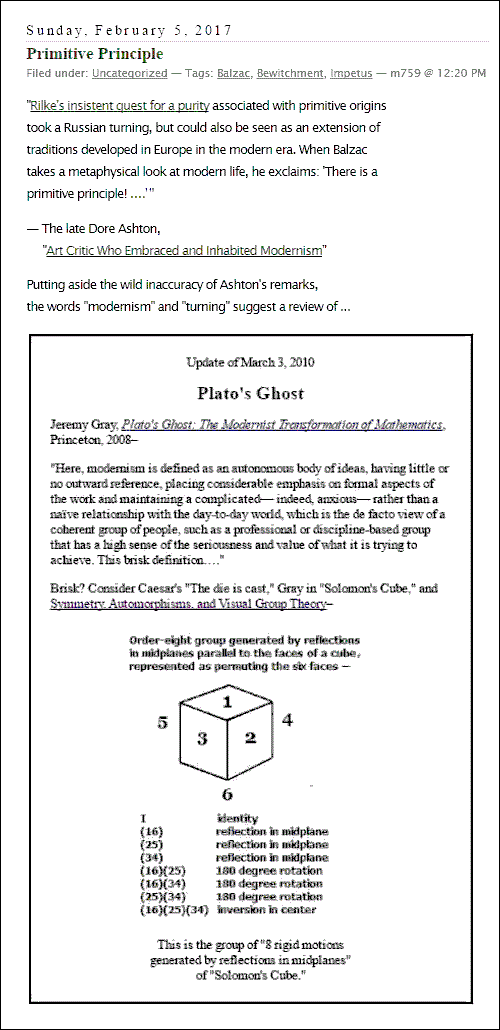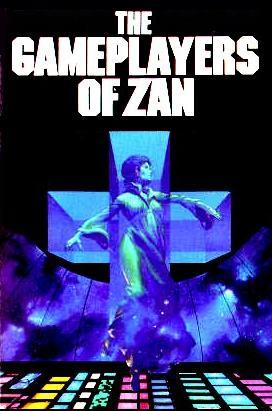From a Log24 search for "High Beam" —
Monday, October 23, 2023
Friday, March 10, 2017
Sunday, March 12, 2017
Raise High the Ridgepole, Architects*
A post suggested by remarks of J. D. Salinger in
The New Yorker of November 19, 1955 —
|
Wikipedia: Taiji (philosophy) Etymology The word 太極 comes from I Ching : "易有太極,是生兩儀,兩儀生四象,四象生八卦,八卦定吉凶,吉凶生大業。" Taiji (太極) is a compound of tai 太 "great; grand; supreme; extreme; very; too" (a superlative variant of da 大 "big; large; great; very") and ji 極 "pole; roof ridge; highest/utmost point; extreme; earth's pole; reach the end; attain; exhaust". In analogy with the figurative meanings of English pole, Chinese ji 極 "ridgepole" can mean "geographical pole; direction" (e.g., siji 四極 "four corners of the earth; world's end"), "magnetic pole" (Beiji 北極 "North Pole" or yinji 陰極 "negative pole; cathode"), or "celestial pole" (baji 八極 "farthest points of the universe; remotest place"). Combining the two words, 太極 means "the source, the beginning of the world". Common English translations of the cosmological Taiji are the "Supreme Ultimate" (Le Blanc 1985, Zhang and Ryden 2002) or "Great Ultimate" (Chen 1989, Robinet 2008); but other versions are the "Supreme Pole" (Needham and Ronan 1978), "Great Absolute", or "Supreme Polarity" (Adler 1999). |
See also Polarity in this journal.
* A phrase adapted, via Salinger,
from a poem by Sappho—
Ἴψοι δὴ τὸ μέλαθρον,
Υ᾽μήναον
ἀέρρετε τέκτονεσ ἄνδρεσ,
Υ᾽μήναον
γάμβροσ ἔρχεται ἶσοσ Ά᾽ρευϊ,
[Υ᾽μήναον]
ανδροσ μεγάλο πόλυ μείζων
[Υ᾽μήναον]
Sunday, April 16, 2023
Latin Club Special —
Rated XXX !
"There were questions in the eyes of other dancers
As we floated over the floor
There were questions but my heart knew all the answers
And perhaps a few things more"
— Song lyric, "Polka Dots and Moonbeams"
Saturday, March 11, 2017
Transformer Group*
"Before time began, there was the Cube." — Transformers (2007)
Plot summary — "An ancient struggle between two Cybertronian races,
the heroic Autobots and the evil Decepticons, comes to Earth, with
a clue to the ultimate power held by a teenager."
* A post suggested by J. D. Salinger's phrase "a fresh impetus"
in "Raise High the Roof Beam, Carpenters" (1955)
Friday, March 10, 2017
The Transformers
"The transformed urban interior is the spatial organisation of
an achiever, one who has crossed the class divide and who uses
space to express his membership of, not aspirations towards,
an ascendant class in our society: the class of those people who
earn their living by transformation— as opposed to the mere
reproduction— of symbols, such as writers, designers, and
academics"
— The Social Logic of Space ,
by Bill Hillier and Julienne Hanson,
Cambridge University Press, 1984
For another perspective on the achievers, see The Deceivers .
Related material —
Exhibit A:
Exhibit B:
Exhibit C:
Wednesday, September 17, 2014
The Horse
A New York Times piece today on author Donald Antrim:
“The next project is a novel ‘about’ (having loosely to do with)
his father, Harry, a T. S. Eliot scholar who wrote a well-regarded
monograph on the poet.”
— John Jeremiah Sullivan
From Harry T. Antrim’s 1967 thesis on Eliot:
“That words can be made to reach across the void
left by the disappearance of God (and hence of all
Absolutes) and thereby reestablish some basis of
relation with forms existing outside the subjective
and ego-centered self has been one of the chief
concerns of the first half of the twentieth century.”
An epigraph selected by Sullivan for a 2002 Harper’s Magazine
article, “Horseman, Pass By“—
Far back, far back in our dark soul
the horse prances.
— D. H. Lawrence
A related image from pure mathematics
(a source of Absolutes unrelated to theology):

See April 9, 2004, for a post on the “Horseman” article.
Monday, April 9, 2012
Eightfold Cube Revisited
A search today (Élie Cartan's birthday) for material related to triality*
yielded references to something that has been called a Bhargava cube .
Two pages from a 2006 paper by Bhargava—


Bhargava's reference [4] above for "the story of the cube" is to…
Higher Composition Laws I:
A New View on Gauss Composition,
and Quadratic Generalizations
Manjul Bhargava
The Annals of Mathematics
Second Series, Vol. 159, No. 1 (Jan., 2004), pp. 217-250
Published by: Annals of Mathematics
Article Stable URL: http://www.jstor.org/stable/3597249
A brief account in the context of embedding problems (click to enlarge)—
For more ways of slicing a cube,
see The Eightfold Cube —
* Note (1) some remarks by Tony Smith
related to the above Dynkin diagram
and (2) another colorful variation on the diagram.
Saturday, March 13, 2010
ART WARS continued…
Wikipedia states that painter R.B. Kitaj (see previous references) was the model for the protagonist of the Philip Roth novel Sabbath's Theater.
A Google search shows that the article (no longer online) on Kitaj cited as a source by Wikipedia does indeed make this claim–
In-Your-Face Outsider | Jerusalem Report | Jerusalem Post
By MATT NESVISKY … not least, Philip Roth, who modeled
the protagonist of the 1995 novel "Sabbath's Theater" largely after Kitaj. …
www.jpost.com/servlet/Satellite?apage=2&cid=1192380767901…
The rest of Nesvisky's article may or may not support his claim. It is available by subscribing to HighBeam.
Related material–
The New York Times on Oct. 24, 2007–
R. B. Kitaj, Painter of Moody Human Dramas, Dies at 74Ileana Sonnabend, Art World Figure, Dies at 92Ileana Sonnabend’s eye, shrewdness and lasting alliance with her first husband, Leo Castelli, made her one of the most formidable contemporary art dealers of her time. |
"Sonnabend" means "Saturday" in German.
Some say the Sabbath is Saturday, others say Sunday.
Here is the Log24 entry for the day that
Kitaj and Sonnabend died– a Sunday—
Sunday October 21, 2007Halloween “The Game in the Ship cannot be approached as a job, a vocation, a career, or a recreation. To the contrary, it is Life and Death itself at work there. In the Inner Game, we call the Game Dhum Welur, the Mind of God. And that Mind is a terrible mind, that one may not face directly and remain whole. Some of the forerunners guessed it long ago– first the Hebrews far back in time, others along the way, and they wisely left it alone, left the Arcana alone.”
|
The New York Times on Sonnabend:
… Also talked about was the Sonnabend 1991 show of Jeff Koons’s “Made in Heaven” series of paintings and sculptures that showed the artist engaged in sexual acts with his wife, Ilona Staller.
Mrs. Sonnabend was variously described as “an iron marshmallow” and “a cross between Buddha and Machiavelli.” Short and plump, she was grandmotherly in appearance from a relatively early age due in part to an illness that necessitated a wig.
Her genteel, old Europe manner belied an often imperious yet bohemian and self-deprecating personality. Her soft, fluty voice often left a listener unprepared for the force of her comments, which she could deliver in at least five languages.
Happy Women's History Month.
Friday, July 11, 2008
Friday July 11, 2008
continued from July 3
"I say high, you say low,
you say why,
and I say I don't know.
Oh, no.
You say goodbye
and I say hello."
— Hello Goodbye *
Thanks to NBC Nightly News tonight for a story on the following:
Manhattanhenge is an evening when "the Sun sets in exact alignment with the Manhattan grid, fully illuminating every single cross-street…."
Full Sun on grid:
Friday, July 11–
8:24 PM EDT
Related material from the late
Tom Disch on St. Sarah's Day:
| Saturday, May 24th, 2008 9:15 pm
What I Can See from Here
I face east toward the western wall Of a tall many-windowed building Some distance off. I don't see the sunset Directly, only as it is reflected From the facade of that building. Those familiar with Manhattan know How the evening sun appears to slide Into the slot of any east/west street, And so its beams are channeled Along those canyon streets to strike Large objects like that wall And scrawl their anti-shadows there, A Tau of twilight luminescence At close of day. I've seen this For some forty years and only tonight Did I realize what I had been looking at: The way god tries to say good-bye. |
* Walter Everett, in The Beatles as Musicians , has a note on the song "Hello Goodbye"–
"189. The extra-long coda… was referred to as the 'Maori finale' from the start…."
(Updated Feb. 27, 2013, to replace an incorrect reference in the footnote
to a book by Stanley Cavell instead of the correct book, by Walter Everett.)
Thursday, September 11, 2003
Thursday September 11, 2003
Particularity
|
|
|
Upon learning of the recent death of Walter J. Ong, S. J., philosopher of language, I ordered a copy of his book
Hopkins, the Self, and God
University of Toronto Press, 1986.
As the reader of my previous entry will discover, I have a very low opinion of the literary skills of the first Christians. This sect’s writing has, however, improved in the past two millennia.
Despite my low opinion of the early Christians, I am still not convinced their religion is totally unfounded. Hence my ordering of the Ong book. Since then, I have also ordered two other books, reflecting my interests in philosophical fiction (see previous entry) and in philosophy itself:
Philosophical fiction —
The Hex Witch of Seldom,
by Nancy Springer,
Penguin Putnam Inc., 2002
(See 1 Corinthians 1:26-29)
Philosophy —
Definition,
by Richard Robinson,
Fellow of Oriel College, Oxford,
Oxford U. Press, 1954, reprinted 1962.
Following the scientific advice of Niels Bohr and Freeman Dyson, I articulated on April 25, 2003, a mad theory of the mystical significance of the number 162.
Here is that theory applied to the three works named above, all three of which I received, synchronistically, today.
Page 162 of Hopkins, the Self, and God is part of the long list of references at the back of the book. Undiscouraged by the seeming insignificance (vide my note Dogma) of this page, I looked more closely. Behold, there was Christ… Carol T. Christ, that is, author of The Finer Optic: The Aesthetic of Particularity in Victorian Poetry, Yale University Press, 1975. “Particularity” seemed an apt description of my “162” approach to literature, so I consulted Christ’s remarks as described in the main body of Ong’s book.
Particularity according to Christ —
“Victorian particularist aesthetics has prospered to the present time, and not only in novels. The isolated, particularized, unique ‘good moment’ [Christ, 105], the flash of awareness at one particular instant in just the right setting, which Hopkins celebrates….”
— Ong, Hopkins, the Self, and God, p. 14
I highly recommend the rest of Ong’s remarks on particularity.
Turning to the other two of the literary trinity of books I received today….
Page 162 of The Hex Witch of Seldom has the following:
“There was a loaf of Stroehmann’s Sunbeam Bread in the grocery sack also; she and Witchie each had several slices. Bobbi folded and compressed hers into little squares and popped each slice into her mouth all at once.”
The religious significance of this passage seems, in Ong’s Jesuit context, quite clear.
Page 162 of Definition has the following:
“Real Definition as the Search for a Key. Mr. Santayana, in his book on The Sense of Beauty, made the following extremely large demands on real definition:
‘A definition <of beauty> that should really define must be nothing less than the exposition of the origin, place, and elements of beauty as an object of human experience. We must learn from it, as far as possible, why, when, and how beauty appears, what conditions an object must fulfil to be beautiful, what elements of our nature make us sensible of beauty, and what the relation is between the constitution of the object and the excitement of our sensibility. Nothing less will really define beauty or make us understand what aesthetic appreciation is. The definition of beauty in this sense will be the task of this whole book, a task that can be only very imperfectly accomplished within its limits.’ ”
Here is a rhetorical exercise for Jesuits that James Joyce might appreciate:
Discuss Bobbi’s “little squares” of bread as the Body of Christ. Formulate, using Santayana’s criteria, a definition of beauty that includes this sacrament.
Refer, if necessary, to
the log24.net entries
Mr. Holland’s Week and Elegance.
Refrain from using the phrase
“scandal of particularity”
unless you can use it as well as
Annie Dillard.















